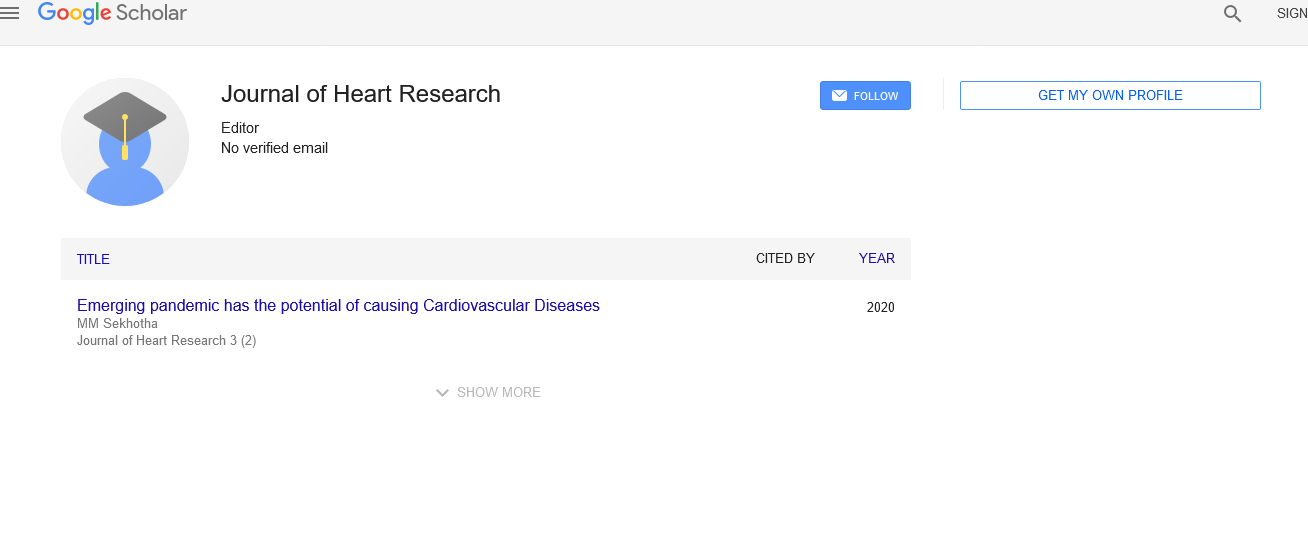The function of paracrine interaction between myeloid and endothelial cells in cardiac angiogenesis and the repair of infarcted hearts
Received: 29-Sep-2022, Manuscript No. puljhr-22-5553; Editor assigned: 01-Oct-2022, Pre QC No. puljhr-22-5553 (PQ); Accepted Date: Oct 25, 2022; Reviewed: 14-Oct-2022 QC No. puljhr-22-5553 (Q); Revised: 21-Oct-2022, Manuscript No. puljhr-22-5553 (R); Published: 28-Oct-2022, DOI: 10.37532 puljhr.2022.5(5). 01-02
Citation: Prantl S. The function of paracrine interaction between myeloid and endothelial cells in cardiac angiogenesis and the repair of infarcted hearts. Int J. Heart Res. 2022; 5(5):1-2.
This open-access article is distributed under the terms of the Creative Commons Attribution Non-Commercial License (CC BY-NC) (http://creativecommons.org/licenses/by-nc/4.0/), which permits reuse, distribution and reproduction of the article, provided that the original work is properly cited and the reuse is restricted to noncommercial purposes. For commercial reuse, contact reprints@pulsus.com
Introduction
schemic heart disease is one of the main causes of illness and mortality. It is mostly brought on by plaque development in the coronary arteries, which causes them to constrict or close, limiting the amount of oxygen and nutrients that can reach the heart muscle. As a result, Cardiomyocytes (CMs) die necrotically. Damage-Associated Molecular Patterns (DAMPs), which are produced by CM necrosis and attract immune cells from the Bone Marrow (BM), include cytokines, chemokines. Immune cells that have been infiltrated release cytokines and proteases that control fibroblast activation and inflammatory reactions [1]. Myocardial remodelling and dysfunction result from the replacement of the injured heart muscle with extracellular matrix made by activated fibroblasts. The performance of the infarcted heart was enhanced by efforts to regenerate blood vessels, also known as therapeutic angiogenesis, which decreased fibrosis. Unfavorable cardiac remodelling might be prevented by the provision of oxygen and nutrients provided by new blood vessels, which would also promote the health and function of the surviving cardiovascular cells and ensure CM survival. Treatment angiogenesis has thus been regarded as one of the key therapeutic modalities for ischemic heart disorders [2]
The ability of stem cells and/or their secretory factors to affect host cell migration, cellular functioning, cardiomyocyte survival, tissue regeneration, and healing is considered a promising aspect of stem cell therapy in the treatment of coronary heart disease, including MI. The utilisation of stem cells and/or their secretory factors may result in therapeutic procedures that are efficient in lowering the size of the infarct, producing more heart tissue that is functional, eradicating heart failure, and extending the lives of MI patients. The current review emphasises the significance of oxidative stress and the immune system in the pathophysiology of acute MI and focuses primarily on mesodermal stem cells because of their antioxidant and immunomodulatory capabilities, including mesenchymal, muscle, and blood vessel-derived stem cells [3].
Even though the specifics of the beginning, development, and management of these processes have not yet been fully elucidated, oxidative stress and inflammation play significant roles in tissue damage, the removal of cell debris, myocardial fibrosis, and remodelling of heart tissue after MI. To better comprehend potential therapeutic targets for employing stem cells or their components outlined in the coming sections, we quickly review the sequence of events related to oxidative stress and inflammation mediated by immune system cells in this part [4].
A third of people globally die from cardiovascular disease, particularly coronary artery disease and stroke, and myocardial infarction, a basic sign of coronary heart disease, is a significant global health issue. The goal of myocardial injury-related angiogenesis promotion has been the main focus of cardiovascular disease research in the past. To improve the prognosis after myocardial infarction, myocardial vascular restoration is essential [5]. The most prevalent nonmyocyte population in cardiac tissue, endothelial cells, is crucial to the process of angiogenesis. Various forms of programmed cell death, including apoptosis, necroptosis, when someone, ferroptosis, and autophagy, have been characterized in recent years and have been discovered to be associated with cardiovascular disorders like myocardial inf-arction, heart failure, and myocarditis. The management of cardiovascular diseases will need to change as a result, which will have significant effects [6].
References
- Van Den Akker F, Deddens JC, Doevendans PA, et al. Cardiac stem cell therapy to modulate inflammation upon myocardial infarction. Biochim Biophys Acta (BBA)-Gen Subj.,2013;1830(2):2449-58.
- Takeda N, Manabe I. Cellular interplay between cardiomyocytes and nonmyocytes in cardiac remodeling. International journal of inflammation. 2011.
- Mause SF, Ritzel E, Liehn EA, et al. Platelet microparticles enhance the vasoregenerative potential of angiogenic early outgrowth cells after vascular injury. Circulation.2010;122(5):495-506.
- Bouchentouf M, Forner KA, Cuerquis J, et al. Induction of cardiac angiogenesis requires killer cell lectin-like receptor 1 and α4β7 integrin expression by NK cells. The Journal of Immunology. 2010;185(11):7014-25.
- Medina RJ, O’Neill CL, O’Doherty TM, et al. Myeloid angiogenic cells act as alternative M2 macrophages and modulate angiogenesis through interleukin-8. Molecular medicine. 2011;17(9):1045-55.
- Shinde AV, Frangogiannis NG. Mediators secreted by myeloid cells may protect and repair the infarcted myocardium. Circulation research. 2015;117(1):10-2.





